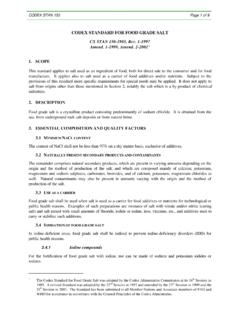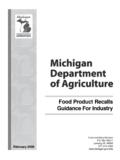Transcription of Antioxidants - FOOD CAN MAKE YOU ILL
1 Antioxidants The truth about BHA, BHT, TBHQ and other Antioxidants used as food additives Sharla Race Antioxidants The truth about BHA, BHT, TBHQ and other Antioxidants used as food additives . Copyright 2009 Sharla Race All rights reserved First published 2009 ISBN: 9781907119002 PDF Edition Published by Tigmor Books For more information on food Intolerance please visit Table of Contents Welcome .. 1 Important Information .. 3 Definitions .. 4 Introduction .. 5 Part One: The Antioxidants .. 6 BHA, BHT and TBHQ .. 7 Gallates .. 12 Erythorbic acid (E315) and Sodium erythorbate (E316) .. 14 4- Hexylresorcinol (E586) .. 15 Tocopherols .. 16 Ascorbic Acid .. 17 Part 2: Health Concerns .. 19 Health Concerns: Introduction .. 20 BHA, BHT and TBHQ.
2 22 General .. 22 Dermatitis .. 23 Urticaria .. 24 Skin Conditions: General .. 24 Asthma .. 25 Behaviour .. 25 26 Other Concerns .. 27 Some Observations .. 27 Health Benefits .. 28 Gallates .. 30 Hidden Antioxidants .. 31 Ingredients List .. 31 Processing Aids .. 33 Packaging .. 34 Flavours and Colours .. 36 Dietary Supplements .. 37 Workplace .. 37 Avoiding Gallates, BHA, BHT and TBHQ .. 36 End Word .. 40 Appendix One: Antioxidants allowed in the UK .. 42 References .. 43 Useful Links .. 46 Antioxidants 1 Welcome The aim of this book is to present you with information on one set of food additives currently widely in use - Antioxidants . It is my intention to produce a s eries of these books dealing with the various categories of food additives . You can find out more on the food Can Make You Ill website ( ). food additives serve many purposes including preserving food , improving its texture, enhancing or improving the flavour, improving its appearance, and prolonging its shelf life.
3 To provide the variety and range of food products currently on our supermarket shelves, food manufacturers need to use food additives . Without additives , only the basic food staples meat, fruit, vegetables, and grains would be available in their unprocessed forms. Concerns raised by consumers about food additives are sometimes seen, by food manufacturers, as a form of ignorance. If only we understood more about how additives are produced and tested and how our bodies are able to metabolize and detoxify the myriad of food constituents we are exposed to daily then we would have no grounds for our We really are being a little silly but are we? food additives , with a very few exceptions, are not substances we would ordinarily add to our food and f ood is a complex enough product before anything synthetic is added to it. Our bodies will do the best they can to keep us going regardless of what we eat but that does not mean that we will experience good health.
4 There exists a vast body of research indicating that exposure to most dietary food additives , at levels typically found in food , poses no hazard for the general population. However, as Borzelleca points out, considering the population s biological diversity, it would not be surprising if some individuals were susceptible to certain food additives . He goes on to note that a nearly infinite number of synergistic or antagonistic interactions are possible between food additives , other dietary components and pharmaceuticals .3 Antioxidants 2 It is impossible for anyone to test for all of these permutations and even if it was we could never hope to retain all this information when we do our shopping. So, we are placed in a si tuation of having to accept that the regulations our governments have put in place are adequate enough to protect us.
5 In most cases, hopefully, they are but for some of us they are not enough and we experience health problems that may never be diagnosed correctly. Very few doctors will consider even food intolerance as a cause of health problems let alone food additives so it is likely that there are many people suffering with an array of symptoms that no doctor has been able to treat simply because they have not looked for the cause in the right place. I do not believe food additives are intrinsically harmful and am certainly not on any crusade to have them banned. What does concern me is that we, as consumers, generally, know very little about them and the reality is that some food additives do cause harm to some people yet they are rarely investigated as the cause of health problems. My purpose within these books is to provide you with information on just what these additives are, how they are used, and how they may cause health problems for some of us.
6 Please be aware that the legislation referred to in this book, unless otherwise stated, is that of the EU. I have included references to all major sources of information used. The majority of studies that have been carried out on the safety of food additives are animal studies I do mention these (it is hard to write this type book and totally exclude them) but I have either only read an abstract or a summary in a research paper that cites them. Ethical considerations aside, I am unconvinced by the direct relevance of animal studies to humans. Also, the evidence within them, because it is not directly transferable to humans, is open to various forms of interpretation so no definitive conclusion can ever be reached. Antioxidants 3 Important Information Your health is the most precious resource you have cherish and nurture it.
7 If reading this book raises any concerns for you about your health please consult your doctor. Any proposed changes to your diet should also be discussed with your doctor and under absolutely NO circumstances should you stop taking any form of prescribed medication without the consent of the medical practitioner who prescribed it. It is my hope that you will find the information in this book useful and helpful but the responsibility for what you do w ith the information you read is completely your own. Sharla Race Antioxidants 4 Definitions ADI: stands for Acceptable Daily Intake . This is an estimate of the amount of a substance in food or drinking water, expressed on a body-weight basis, that can be ingested daily over a lifetime without appreciable risk (the standard human is calculated at 60kg). The ADI is listed in units of mg per kg of body weight.
8 Not all additives have an ADI as they are deemed to be of no risk if used within standard food manufacturing guidelines. A level of quantum satis (QS) is set. QS means that additives shall be used in the food concerned in accordance with good manufacturing practice. This means that an additive must not be used at a level higher than is necessary to achieve the intended purpose and must not be used in a way that misleads the consumer. Antioxidant: a substance which prolongs the shelf life of foodstuffs by protecting them against deterioration caused by oxidation, such as fat rancidity and colour changes. Compound Ingredients: ingredients of a food which are themselves made up of two or more ingredients ( mayonnaise, salami, custard, seasoning). A list of ingredients within the compound ingredient is usually shown in brackets; for example, Mayonnaise (egg, water, oil, vinegar, mustard, salt).
9 food additive: a substance added intentionally to foodstuffs to perform certain technological functions, for example to colour, to sweeten or to preserve. food additives are defined in EU legislation as "any substance not normally consumed as a food in itself and not normally used as a characteristic ingredient of food whether or not it has nutritive value, the intentional addition of which to food for a t echnological purpose in the manufacture, processing, preparation, treatment, packaging, transport or storage of such food r esults, or may be reasonably expected to result, in it or its by-products becoming directly or indirectly a component of such foods."2 Ingredient: any substance, including any additive and any constituent of a compound ingredient, which is used in the preparation of a food and which is still present in the finished product, even if in an altered form.
10 Ingredients List: the ingredients used in the manufacture of a food are listed in descending order of weight at the time of their use in the preparation of the food . If any of the ingredients make up less than 2% of the product they do not have to be listed in weight order but have to be declared by use of the term also contains . Processing Aid: a substance that is intentionally used for the processing of raw materials, foods or ingredients to fulfil a certain technological purpose during processing. A processing aid would not be consumed as a food ingredient itself. Antioxidants 5 Introduction Antioxidants occur naturally in many foods and are essential for our health. They include Vitamin C found in fruit and vegetables and vitamin E found in seeds and nuts. Antioxidants , both natural and synthetic, are used by the food industry as food additives to help prolong the shelf life and appearance of many foodstuffs.





